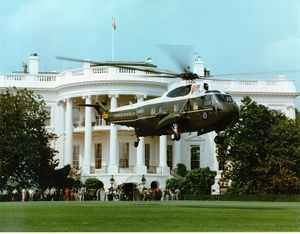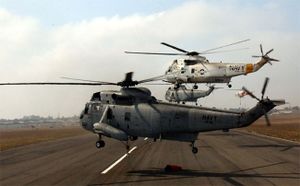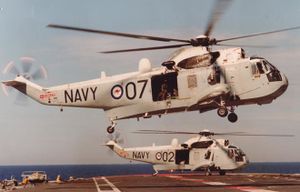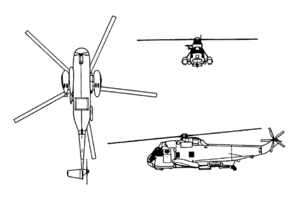PlaneSpottingWorld welcomes all new members! Please gives your ideas at the Terminal.
SH-3 Sea King
| SH-3 Sea King | |
|---|---|
| US Navy SH-3H Sea King helicopters | |
| Type | ASW/Medium-lift transport/utility helicopter |
| Manufacturer | Sikorsky |
| Maiden flight | 1959 |
| Status | Active service |
| Primary users | United States Navy Italian Navy Brazilian Navy Japan Maritime Self Defence Force |
| Variants | Sikorsky S-61L/N Sikorsky S-61R Westland Sea King CH-124 Sea King |
The Sikorsky SH-3 Sea King (company designation S-61) is a twin-engined anti-submarine warfare (ASW) helicopter. It served with the United States Navy and other forces, and continues to serve in many countries around the world. The Sea King has been built under license in Italy, Japan, and the United Kingdom. The major civil versions are the S-61L and S-61N.
Contents
Development
In 1957, Sikorsky was awarded a contract to develop an all-weather amphibious helicopter. It would combine submarine hunter and killer roles. The prototype flew on March 11, 1959. It became operational with the United States Navy in June 1961 as the HSS-2. The designation for the aircraft was changed with the introduction of the unified aircraft designation system in 1962 to the SH-3A. It was used primarily for anti-submarine warfare, but also served in anti-ship, search and rescue, transport, communications, executive transport and Airborne Early Warning roles
Design
It was designed for shipboard operations, as the five main rotor blades as well as tail section with its five blades can be folded for easy stowage. Because of its amphibious hull, the Sea King has the ability to land on water. However, this is a risky maneuver and used only in emergencies, as the hull can only remain watertight for a limited period of time.[citation needed] The sponsons were fitted with deployable airbags to enhance floatation.
Armaments and equipment of Sea Kings vary widely with their role. Typical armaments can be four torpedoes, four depth charges or two anti-ship missiles (Sea Eagle or Exocet). A large Chaff Pod was sometimes carried for anti-ship missile defense of the Carrier Battle Group. ASW equipment included a dipping sonar, sonobouys, Magnetic Anomaly Detector, and Data link. In the Search and Rescue role the cabin can accommodate 22 survivors or nine stretchers and two medical officers. In the troop transport role 28 soldiers can be accommodated.
Operational service

Aircraft carriers always deployed the Sea King as the first aircraft in the air and the last to land serving in air operations as plane guard and SAR for the fixed winged aircraft. An SH-3A, operating from the USS New Orleans amphibious assault ship, was used in the February 1971 Apollo 14 recovery mission.
In the US Navy, it was replaced in the ASW and S&R roles by the SH-60 Sea Hawk during the 1990s, but continues in service for other roles, for ASW in the reserves, and around the world. All H-3 aircraft in US Navy service are used in the logistics support, range support, Search and Rescue, test, and VIP transport roles. The H-3 was finally retired on January 27, 2006 in a Final Flight ceramony in NAS Norfolk, Virginia, by Helicopter Combat Support Squadron 2 (HC-2), the Fleet Angels.
A Sea King is used as one of the official helicopters of the President of the United States and is operated by the United States Marine Corps. It is known as Marine One when the president is actually aboard.
Variants
US military
- XHSS-2
- The only prototype of the H-3 Sea King.
- YHSS-2
- Prototype and trials aircraft. Seven helicopters were built for the US Navy.
- SH-3A
- Anti-submarine warfare helicopter for the US Navy (245 built); originally designated HSS-2.
- HH-3A
- Search and rescue helicopter for the US Navy (12 converted from SH-3A).
- CH-3A
- Military transport version for the US Air Force (3 converted from SH-3A later became CH-3B).
- NH-3A
- Experimental version, with wings and turbojet engines (1 Converted from SH-3A).
- RH-3A
- Minesweeper helicopter for the US Navy (9 converted from SH-3A).
- VH-3A
- VIP transport helicopter for the US Army & Marine Corps (8 built, plus 2 SH-3A (STAKE) conversions which were rebuild from damaged helicopters, 1 a YHSS-2 and 1 a SH-3A).
- CH-3B
- Military transport helicopter for the US Air Force.
- SH-3D (S-61B) (HSS-2A)
- Anti-submarine warfare helicopter for the US Navy (73 built and two conversion from SH-3A). Also operated by the Islamic Republic of Iran Navy Aviation.
- SH-3D (S-61B)
- Anti-submarine warfare helicopter for the Spanish Navy (6 built).
- SH-3D-TS
- Anti-submarine warfare version.
- VH-3D
- VIP transport helicopter for the US Marine Corps.
- SH-3G
- Cargo, utility transport helicopter for the US Navy (105 Conversions from SH-3A and SH-3D).
- SH-3H (HSS-2B)
- Anti-submarine warfare helicopter for the US Navy (Conversions from older versions).
- SH-3H AEW
- Airborne early warning version for the Spanish navy.
- UH-3H
- cargo, utility transport version for the US Navy.
Sikorsky
- S-61
- Company designation for the H-3 Sea King.
- S-61A
- Export version for the Royal Danish Air Force.
- S-61A-4 Nuri
- Military transport, search and rescue helicopter for the Royal Malaysian Air Force. It can seat up to 31 combat troops (38 built).
- S-61A/AH
- Utility helicopter for survey work and search and rescue in the Antarctic.
- S-61B
- Export version of the SH-3 anti-submarine warfare helicopter for the Japanese Maritime Self Defence Force.
- S-61D-3
- Export version for the Brazilian Navy.
- S-61D-4
- Export version for the Argentine Navy.
- S-61NR
- Search and rescue version for the Argentine Air Force.
- S-61L/N
- Civil versions of the Sea King.
- S-61R
- The S-61R served in the United States Air Force as the CH-3C/E Sea King and the HH-3E Jolly Green Giant, and with the United States Coast Guard and the Italian Air Force as the HH-3F Sea King (more commonly referred to by the nickname "Pelican").[1]
- S-61V
- Company designation for the VH-3A, (1 built for Indonesia).
United Aircraft of Canada
- CH-124
- Anti-submarine warfare helicopter for the Canadian Navy.
Westland
The Westland Sea King variant was manufactured under license by Westland Helicopters, Ltd. in the United Kingdom, who developed a specially modified version for the Royal Navy. It is powered by a pair of Rolls-Royce Gnome turbines, and has British avionics and ASW equipment. This variant first flew in 1969, and entered service the next year. It is also used by the Royal Air Force and has been sold round the world.
Agusta
- AS-61
- Company designation for the H-3 Sea King built under licence in Italy by Agusta.
- AS-61A-1
- Italian export model for the Royal Malaysian Air Force.
- AS-61A-4
- Military transport helicopter, search and rescue helicopter. Built under licence in Italy by Agusta.
- AS-61N-1 Silver
- License built model of the S-61N, with a shortened cabin.
- AS-61VIP
- VIP transport helicopter. Built under licence in Italy by Agusta.
- ASH-3A (SH-3G)
- Utility transport helicopter. Built under licence in Italy by Agusta.
- ASH-3D
- Anti-submarine warfare helicopter. Built under licence in Italy by Agusta. Flown by the Italian, Brazilian, Peruvian and Argentinian navies.
- ASH-3TS
- VIP, executive transport mission helicopter. Built under licence in Italy by Agusta. Also known as the ASH-3D/TS.
- ASH-3H
- Anti-submarine warfare helicopter. Built under licence in Italy by Agusta.
Mitsubishi
- S-61A
- Licence built-version of the S-61A as Search-and-Rescue and Utilty helicopters for the Japan Maritime Self Defence Force (18 Built)
- HSS-2
- Licence built version of the S-61B as an Anti-submarine warfare helicopter for the Japan Maritime Self Defence Force (55 Built).
- HSS-2A
- Licence built version of the S-61B(SH-3D) as an Anti-submarine warfare helicopter for the Japan Maritime Self Defence Force (28 Built).
- HSS-2B
- Licence built version of the S-61B(SH-3H) as an Anti-submarine warfare helicopter for the Japan Maritime Self Defence Force (23 Built).
Operators
- Template:ARG
- Template:AUS
- Template:BEL
- Template:BRA
- Template:CAN
- Template:DNK
- Template:EGY
- Template:GER
- Template:IND
- Template:IRN
- Template:IRQ
- Template:IRL
- Template:ITA
- Template:JPN
- Template:MYS
- Template:NOR
- Template:PAK
- Template:PER
- Template:QAT
- Template:SAU
- Template:ESP
- Template:THA
- Template:VEN
- Template:UK
- Template:USA
Specifications (SH-3)
General characteristics
- Crew: 4 (2 pilots, 2 ASW systems operators)
- Capacity: 3 passengers
- Length: 54 ft 9 in (16.7 m)
- Rotor diameter: 62 ft (19 m)
- Height: 16 ft 10 in (5.13 m)
- Disc area: ft² (m²)
- Empty weight: 11,865 lb (5,382 kg)
- Loaded weight: 18,626 lb (8,449 kg)
- Max takeoff weight: 22,050 lb (10,000 kg)
- Powerplant: 2× General Electric T58-GE-10 turboshafts, 1,400 shp (kW) each
Performance
- Maximum speed: 166 mph (267 km/h)
- Range: 621 mi (1,000 km)
- Service ceiling: 14,700 ft (4,481 m)
- Rate of climb: 1,310-2,220 ft/min (400-670 m/min)
Armament
- 2× Mk 46/44 anti-submarine torpedoes (SH-3H)
- Various sonobouys and pyrotechnic devices
- B-57 Nuclear depth charge
- Door guns and gun turrets on some variants (see Main article: U.S. Helicopter Armament Subsystems)
References
Citations
- ↑ United States, 1974. pg. A-40; 1998. pg. A-43; 2004. pg. 43
Sources
- United States. Department of Defense. DOD 4120.15-L Model Designation of Military Aircraft, Rockets, and Guided Missiles. Washington, DC: Department of Defense, 1974.
- United States. Department of Defense. DOD 4120.15-L Model Designation of Military Aircraft, Rockets, and Guided Missiles. Washington, DC: Department of Defense, 1998.
- United States. Department of Defense. DOD 4120.15-L Model Designation of Military Aircraft, Rockets, and Guided Missiles. Washington, DC: Department of Defense, 2004.
External links
- US Navy Fact File
- UK Defence Industries Site
- Download Sea King for Flight Simulator
- S-61 Specs & Photo on flugzeuginfo.net
Related content
Related development
Designation sequence
Related lists
Template:USN helicopters Template:US helicopters Template:Sikorsky Aircraft
Lists relating to aviation | |
|---|---|
| General | Timeline of aviation · Aircraft · Aircraft manufacturers · Aircraft engines · Aircraft engine manufacturers · Airports · Airlines |
| Military | Air forces · Aircraft weapons · Missiles · Unmanned aerial vehicles (UAVs) · Experimental aircraft |
| Notable incidents and accidents | Military aviation · Airliners · General aviation · Famous aviation-related deaths |
| Records | Flight airspeed record · Flight distance record · Flight altitude record · Flight endurance record · Most produced aircraft |
Lists relating to aviation | |
|---|---|
| General | Timeline of aviation · Aircraft · Aircraft manufacturers · Aircraft engines · Aircraft engine manufacturers · Airports · Airlines |
| Military | Air forces · Aircraft weapons · Missiles · Unmanned aerial vehicles (UAVs) · Experimental aircraft |
| Notable incidents and accidents | Military aviation · Airliners · General aviation · Famous aviation-related deaths |
| Records | Flight airspeed record · Flight distance record · Flight altitude record · Flight endurance record · Most produced aircraft |





